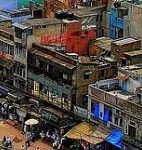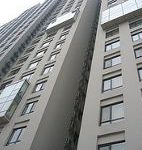Jaime Lerner rarely leaves home without his little black book. In between meetings with Russian senators, European diplomats, Korean politicians or Brazilian governors, the 70-year-old architect and urban planner opens the notebook and scribbles down his latest ideas.
Inside, there are sketches of the "portable street", a plan to transform deserted, rundown city centres into bustling communities. There are blueprints for the Dock-Dock, a tiny, futuristic automobile intended to cut congestion and pollution levels. And there are rap song lyrics.
"It's possible, it's possible! You can do it! You can do it," reads the most recent, entitled The Sustainable Song. "Make the transition. Cut carbon emissions!"
Leaf through the notebook and it is easy to get a sense of the audacious and often eccentric thinking that has made Lerner a hero in his native Brazil and a reference point for architects and city planners the world over. He is celebrated as the mayor who oversaw the once-unthinkable transformation of his hometown, Curitiba, turning a grimy, congested state capital into an economically viable example of green living and social responsibility.
Increasingly, Lerner is hailed as an environmental hero whose notebooks may hold some of the solutions to the problem of climate change — a man on a crusade to improve living and environmental conditions for future generations.
Lerner, the son of Polish immigrants, was born in 1937 in Curitiba, a then-small city in the south of Brazil, which today is home to around 1.8 million people. His fascination with the city began early. As a child, he remembers watching the impoverished immigrant workers streaming off trains in the city's central station outside his house, the politicians scurrying to work in the town hall, and the clowns cavorting in the circus next door. "I did my course of both fantasy and reality on that street," he recalls.
It was a time of huge social change in Brazil, with immigrants from across the world streaming into the country in search of a better future. "I always felt a great connection with the street," he says. "My dream was to be an architect."
After dropping out of engineering school — his local university did not offer a course in architecture at the time — and then finally studying architecture, Lerner began putting his own fantasies into practice in order to confront the realities of his hometown. By the mid-1960s, the population of Curitiba had burgeoned to nearly 500,000 and the problems that all large cities face were starting to appear.
Frustrated by the responses of the authorities, Lerner and a group of young, idealistic architects and engineers began to set out their own designs for the city's future. "I saw things happening that I thought were wrong," he says. "They were destroying the city's history, opening up big roads that wiped out the whole memory of the city, planning the city just for cars."
In contrast, Lerner's master plan for the city involved a mix of affordable, integrated transport as well as social and environmental programmes that would help break down social divisions and bring new life to the capital of Paraná state. In 1971, aged just 33, Lerner was "appointed" mayor by the military regime that ruled Brazil from 1964 to 1985. The Lerner revolution, which would later be replicated in cities from Colombia and Cuba to Russia, began.
"The city of Curitiba became a reference for doing exactly the opposite of what other cities were doing," he says. "Other cities were building big bridges and freeways, and we were making pedestrian streets. Many cities were building metro systems, and we started our own transport system." Key to the transformation was stealth, Lerner believes. "I said: 'We have to do things quickly because next week we might not be here anymore [because of the dictatorship].' And you have to be quick to avoid your own bureaucracy. Bureaucracy is like a fungus that contaminates everything."
Over the following 20 years, a period during which Curitiba underwent drastic, rapid changes, Lerner was mayor three times. "We built the opera house in two months, the botanical gardens in three months, Niemeyer's museum in five months. We transformed the city's main street into a pedestrian area in 72 hours. It wasn't that we were chasing after records — it was necessity."
In 1988 came Lerner's masterpiece, the Rede Integrada de Transporte (RIT), or integrated transport system. The network — later reproduced in Bogotá, Los Angeles and Panama City — involved the construction of futuristic-style "tubos", tube-like street-side bus shelters from which people could travel anywhere in the city for a flat fare. The RIT was, in effect, a low-budget overland subway.
Then there were the recycling projects. Under Lerner, Curitiba began a pioneering project, exchanging food for separated rubbish with the poor in the favelas (shanty towns) that surrounded the city. "Today, Curitiba has the highest level of rubbish separation in the world," Lerner points out with pride.
Lerner recalls: "Brazil was changing, but the population's income was dropping. We realised we had to enter more into the social field — education, health, paying attention to the children. It was a very rich period of innovation."
The signs of Lerner's urban revolution are everywhere: in the once-abandoned quarries and landfill sites that have become parks and recreation areas; in the Lighthouses of Knowledge, educational centres where the city's youth can study and socialise free of charge; in the cultural centres and theatres; and even in the signs hanging from car garages, proudly proclaiming how many tyres they have recycled since the year began.
Curitiba is not perfect, as the wooden shanties near the airport and the rising murder rate indicate, but it is a radically different city from most others in South America. The city's gross domestic product (GDP) is the fourth highest among Brazil's cities, behind only São Paulo, Rio de Janeiro and the capital, Brasília. Curitiba also boasts some of the country’s lowest illiteracy and unemployment rates. "I don't like the word 'model', but Curitiba is a reference point for the whole world," Lerner says.
Buoyed by his successes as mayor, Lerner was elected governor of Paraná state in 1994. And, with paltry resources, he was forced again to look to innovation. "We did a deal with the fisherman," he recalls. "If he fishes fish, the money goes to him. If he fishes rubbish, bottles, glass, cans, we will buy it from him. If the conditions are bad for catching fish, he'll catch rubbish. The more rubbish he gets, the more money he gets and the cleaner the bay gets. The cleaner the bay gets, the more fish he'll be able to fish. It's a win-win solution."
Such initiatives have earned Lerner many fans across the world, and his programmes are today a fixed part of many urban planning curriculums.
In 1975, he was appointed an urban planning consultant by the United Nations. Wally N'Dow, former head of the UN Centre for Human Settlements (Habitat), has described Curitiba as "a wonderful example, because cities that follow this lead can jump-start the economies, assist the poorest of their poor, and clean up their cities."
Since giving up politics in 2002, Lerner has become a kind of international ambassador for sustainable planning. Virtually every week he receives an international delegation in Curitiba at his former home, which is insulated by a grass-covered roof.
Lerner speaks of his hopes for the world's cities with an evangelical passion. All cities are capable of solving problems, he believes, be they the slums of Rio de Janeiro or Caracas or the congestion of London and Paris. "I'm optimistic about cities," he insists. "Mayors who I talk to say, 'This can't be done in my city; it's very big; it has 10, 12 or 15 million people.' Or they say, 'Oh, our country is very poor; our city doesn't have the resources.' And I always say it is not a question of scale or of resources. Any city in the world can improve, and improve a lot, in less than three years."
Lerner also believes that urban planning can be a key weapon against global warming and climate change. "As I'm a descendent of Jews, I have some commandments that we need to follow," he says. "First commandment: use your car less. Second commandment: separate your rubbish. Third: live near to your work, or work near your home. It needs to be about life, work and movement being all together."
The rest, he says, is a question of simplicity. "One of the things I have learned is that we have to be committed to simplicity. There is no need to be scared of simplicity. And we can't want to have all the answers in the world. Many cities end up putting off things because they want to understand everything. They don't understand that innovating is about starting. Taking care of a city is a process that you start, and then give the population space to respond. There is no place in a city that can't be better. There is no toad that can't be a princess, no frog that can't become a prince."
Copyright Guardian News & Media Ltd 2008
Homepage photo by Guihermy



